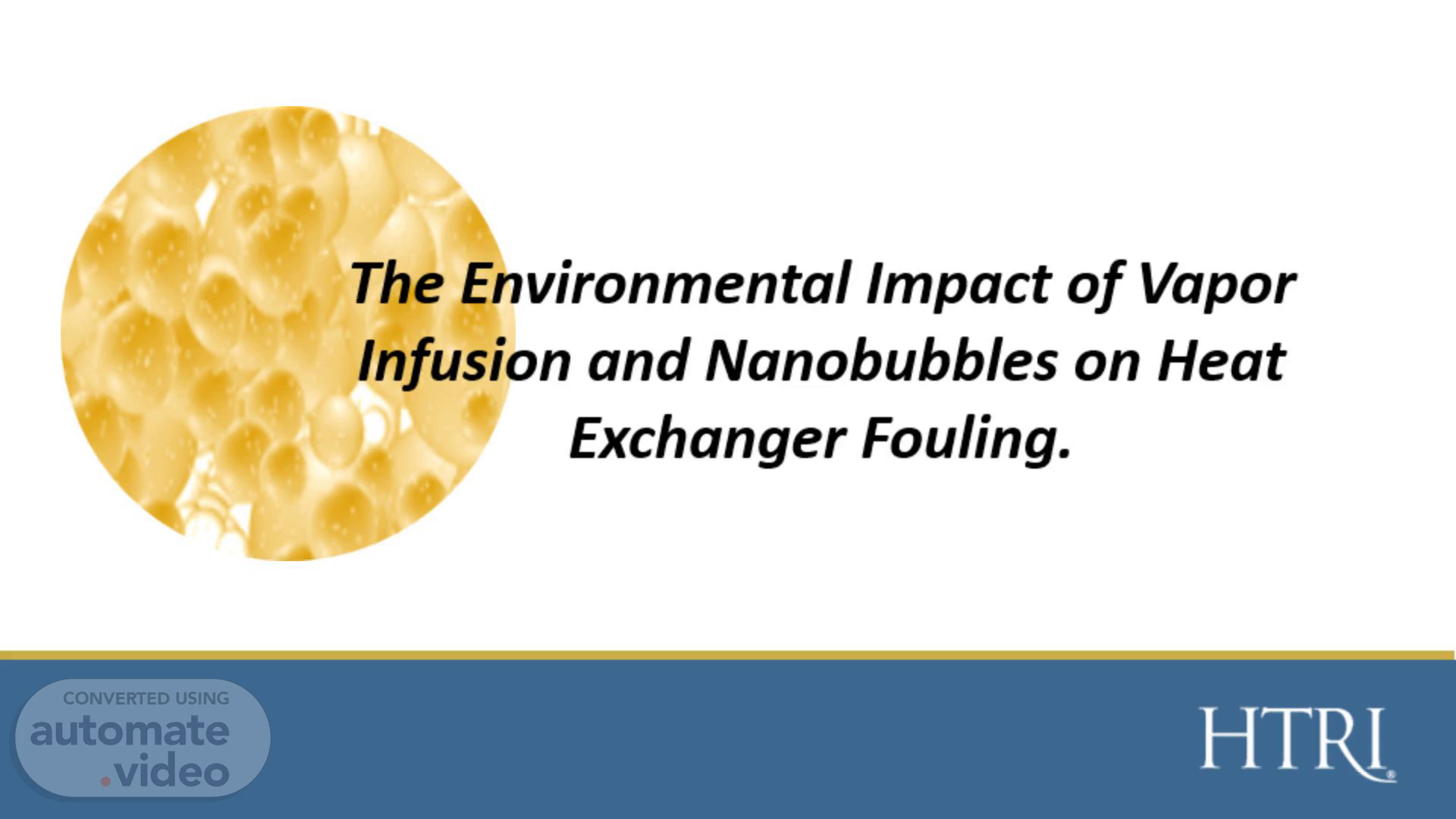
Page 1 (0s)
[Audio] The Environmental Impact of Vapor Infusion and Nanobubbles on Heat Exchanger Fouling..
Page 2 (11s)
[Audio] Fouling related conditions can impair heat exchanger function while increasing the generation of greenhouse gases. This is due to Surface insulation caused by fouling layers. Increased pressure drop due to flow impeded by fouling and the Maldistribution of flow away from heat transfer surfaces..
Page 3 (31s)
[Audio] Over the years, there have been numerous studies that indicate the collateral effect of a fouling heat exchanger on both function and environmental impact..
Page 4 (59s)
[Audio] There have also been many studies that indicate that bubbles, when presented properly, will have a positive impact on heat transfer and foul prevention. Unfortunately, the presentation of dissolved oxygen, through mass transfer, can have a deleterious effect due to induced corrosion and/or accelerated biofouling..
Page 5 (1m 32s)
[Audio] Vapor bubble infusion is a patented process that safely generates a timed presentation of SCRUBBING, transitory multi-sized bubbles into the cooling water stream to help retard the formation of foulants on heat exchanger surfaces while imparting targeted but reduced chemical treatments. Timed infusion works in harmony with most anti-fouling systems and is expressed typically for three minutes every twenty-seven minutes. It is believed a combination of the chemical treatments and shearing creates microbubbles which collapse into nano bubbles which through Brownian motion interact with all exchanger surfaces and are neutrally buoyant thus preventing coalescence and rise..
Page 6 (2m 15s)
[Audio] The bubbles created through vapor bubble infusion reduce the presentation of dissolved oxygen and provide a vehicle for the expression of a chemical treatment. The bubbles offer, Increased turbidity Physical impact Bubble surface chemical treatment expression which, Greatly reduces fluid borne chemical residue..
Page 7 (2m 47s)
[Audio] Having been the recipient of numerous governmental studies, one area of interest was whether a bubble membrane would have impact on the outside environment. Studies merely infusing water with iodine vapor bubbles for ninety seconds indicate a profound inactivation of microbes both planktonic (blue) and biofilm entrained (orange). After infusion, the total iodine content was less than fifty parts per billion. The green chart determined there was a residual disinfection that occurred without repetitive infusion. A single infusion provided disinfection to four new inoculations of log six microbes over a four-hour period. This was the first indication of nanobubble creation..
Page 8 (3m 36s)
[Audio] Numerous papers have been written about the anti fouling and bactericidal effects of nano bubbles..
Page 9 (4m 35s)
[Audio] A study performed by Center for Research in Applied Science and Advanced Technology in Mexico and the Department of Materials Science and Engineering, University of California, Irvine, CA indicates vapor infusion creates extremely dense volumes of extremely small nanobubbles. Furthermore, the bubbles persisted up to 192 hours after a single three-minute infusion. A co-authored paper is available..
Page 10 (5m 3s)
[Audio] Our first client has been foul free for seventeen years without the need for heat exchanger disassembly. The nano bubbles were so effective, diffusion wells fifteen hundred feet away were maintained without direct treatment. The nano bubbles were created within the heat exchanger through shearing and allowed to flow downstream..
Page 11 (5m 38s)
[Audio] Our first US Navy study compared an infused heat exchanger to an uninfused on board a working Navy vessel. Although the success criteria for the navy was an increase in the time period between cleanings by fifty percent (ninety day in lieu of typically sixty days), infusion completely eliminated fouling for two hundred and seventy days, the entire length of the study. In addition, there was total increase in seawater iodine by thirty-five parts per billion and no increase in metallic ion discharge due to the infusion/surface interaction..
Page 12 (6m 13s)
[Audio] The technology has had enormous success on off-shore rigs where robust heat exchanger system function better and remain cleaner than those chemically cleaned. One rig has remained completely foul free for over three years eliminating the need for tear down..
Page 13 (6m 54s)
[Audio] Engine coolers on Norwegian Sun cruise ship have remained clean for over five years. Both sets of main engine coolers, forward and aft, had been in operation without being cleaned for over a year. Fourteen months after installation of the vapor infusion system (after 26 months in operation), each exchanger was opened for observation. Note the condition of the plates. The forward cooler does not filter for shells..
Page 14 (7m 23s)
[Audio] The infusion device has minimal mechanical needs and does not interfere with existing system functionality nor require excessive modification..
Page 15 (7m 56s)
[Audio] Thank you. If you would like further information about a trial, please let us know..